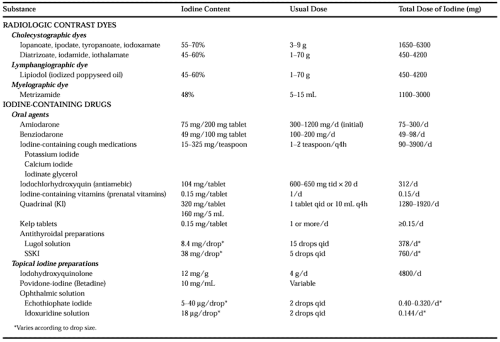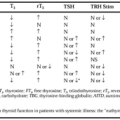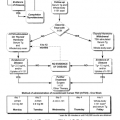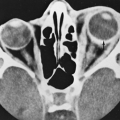IODIDE SOURCES
Part of “CHAPTER 37 – ADVERSE EFFECTS OF IODIDE“
AVERAGE IODIDE INTAKE
The normal thyroid adapts easily to iodide excess or deficiency. Hyperthyroidism or hypothyroidism resulting from abnormal amounts of dietary iodine is unusual. In the United States, dietary iodide intake is estimated to average 350 to 650 μg per day, although it may exceed 1 mg per day in some areas. Some of the major sources are iodinated feed used in the dairy industry (secreted as iodine in cow’s milk), iodates used as dough conditioners in bread baking, iodide in drinking water, and iodide supplements in salt.15a An average of 10 g of iodine-supplemented table salt per day in the American diet provides 76 μg of iodine.16 In some parts of Africa, South America, Europe, the Middle East, and Asia, where iodide-deficiency goiter is prevalent, iodine intake may still average <50 μg per day. By contrast, in Japan and other Asian nations, a diet rich in fish and often supplemented with iodide-rich seaweed (kelp) results in an intake of several milligrams per day.11 Elemental iodine or inorganic iodide salts, once ingested, are reduced to iodide, thereafter becoming available for uptake by the thyroid.
Iodine is a substantial component of many commonly available oral and topical medications, as well as oral and intravenous contrast agents. Table 37-1 lists commonly used iodide-containing compounds, and the iodine dose expected with routine use.
RADIOGRAPHIC CONTRAST AGENTS
Between 180,000 and 320,000 μg of iodine is derived from the radiographic contrast agent given for routine oral cholecystography, and intravenous pyelography presents a dose of >106 μg of iodine. Although most of the iodine in radiologic contrast media is in the form of organic iodine, large amounts of free iodide also are present. These organic iodine compounds may be taken up by peripheral tissues, particularly the liver, where deiodination generates free iodide that can be trapped by the thyroid. Much of the iodine becomes protein bound and circulates in serum, remaining available to the thyroid for prolonged periods after a single exposure. Blood iodide content may increase to 200 times baseline levels after oral cholecystography or intravenous pyelography and remains elevated for days to weeks.14,17
Stay updated, free articles. Join our Telegram channel

Full access? Get Clinical Tree








